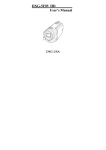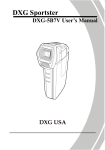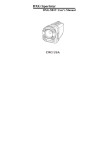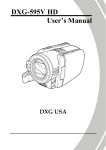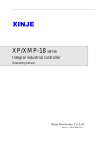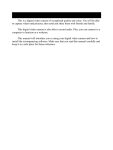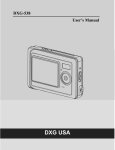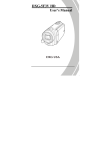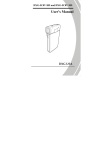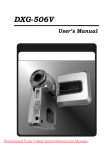Download DXG -581V User`s manual
Transcript
DXG-5B6V User’s Manual DXG USA Table of Contents Preface .............................................................................. v About this manual............................................................. v Copyright........................................................................... v Precautions ...................................................................... vi Before You Start ............................................................. viii 1 Introduction ... Error! Bookmark not defined. 1.1 1.2 1.3 1.4 2 System requirements............................................... 1 Features .................................................................. 1 Unpacking the video camera .................................. 2 About the camera ................................................... 3 1.4.1 Front view ................................................... 3 1.4.2 Top view ..................................................... 3 1.4.3 Bottom view ............................................... 4 1.4.4 Right view ................................................... 4 1.4.5 Left view ..................................................... 5 1.4.6 Back view .................................................... 5 1.4.7 Adjusting the LCD display ....................... 6 1.4.8 About the LEDs ........................................ 10 Getting started ...........................................11 2.1 2.2 2.3 2.4 Inserting an SD card ............................................ 11 Inserting the batteries........................................... 12 Turning on/off the video camera ......................... 13 Changing modes ................................................... 13 i 2.5 Before you start .................................................... 13 2.5.1 Setting the date and time ........................ 13 2.5.2 Setting the language ................................ 14 2.5.3 Setting the beep ........................................ 15 2.6 Recording and playing videos .............................. 17 2.6.1 Shooting a video clip ............................... 17 2.6.2 Recording a voice file .............................. 18 2.6.3 Playing a video clip ................................. 19 2.6.4 Playing a voice file ................................... 20 2.7 Taking and viewing pictures................................. 21 2.7.1 Taking a still picture ................................ 21 2.7.2 Viewing images........................................ 22 2.8 2.9 Connecting to a computer .................................... 23 Connecting to a TV .............................................. 23 3 ii Using the video camera ............................ 25 3.1 Movie mode .......................................................... 25 3.1.1 Movie mode icons.................................... 25 3.1.2 Using the macro function ....................... 26 3.1.3 Using the zoom function......................... 27 3.1.4 Using the LED white light ...................... 27 3.1.5 Quick access controls .............................. 27 3.2 Voice mode ............................................................ 28 3.2.1 Voice mode icons ..................................... 28 3.3 Photo mode ........................................................... 29 3.3.1 Photo mode icons..................................... 29 3.3.2 3.3.3 3.3.4 3.3.5 Using the macro function ....................... 30 Using the zoom function......................... 30 Using the LED white light ...................... 30 Quick access controls .............................. 31 3.4 Movie Playback mode........................................... 32 3.4.1 Movie Playback mode icons ................... 32 3.5 Photo Playback mode ........................................... 33 3.5.1 Photo Playback mode icons .................... 33 3.6 3.7 Thumbnail mode .................................................. 34 USB mode ............................................................. 35 3.7.1 Using the mass storage feature .............. 35 3.7.2 Using the DPS (Direct Print Standard) feature ............................................................. 35 4 Using the menus ....................................... 36 4.1 Movie menu .......................................................... 36 4.1.1. White balance ........................................... 36 4.1.2. Video quality ............................................ 37 4.1.3. Color effect................................................ 38 4.1.4. Resolution ................................................. 39 4.1.5. Capture mode........................................... 40 4.1.6. Stabilizer ................................................... 41 4.2 Movie playback menu........................................... 42 4.2.1 Delete......................................................... 42 4.2.2 Protect ....................................................... 44 4.3 Photo menu .......................................................... 46 iii 4.3.1 4.3.2 4.3.3 4.3.4 4.3.5 4.3.6 4.3.7 White balance ........................................... 46 Image quality............................................ 47 Color effect................................................ 48 Size ............................................................. 49 Date stamp ................................................ 50 Burst mode................................................ 51 Stabilizer ................................................... 52 4.4 Photo playback menu ........................................... 53 4.4.1 Delete......................................................... 53 4.4.2 Protect ....................................................... 55 4.4.3 Autoplay ................................................... 57 4.4.4 DPOF ......................................................... 58 4.5 System menu ......................................................... 60 4.5.1 Language .................................................. 60 4.5.2 Format ....................................................... 60 4.5.3 Default ....................................................... 61 4.5.4 Auto power off ......................................... 62 4.5.5 Frequency ................................................. 63 4.5.6 TV standard .............................................. 64 4.5.7 Date/time ................................................. 65 4.5.8 Beep ........................................................... 65 4.5.9 Memory status.......................................... 65 Appendix............................................................ 66 Specifications .................................................................. 66 Troubleshooting .............................................................. 69 iv Preface Congratulations on your purchase of this advanced video camera. Make sure that you read this manual carefully and keep it in a safe place for future reference. About this manual Every effort has been made to ensure that the contents of this manual are correct and up to date. However, no guarantee is made regarding the accuracy of the contents. If the contents of this manual do not tally with the camera, please take the camera as a criterion. We reserve the right to change the contents of this manual and specifications of the product without prior notice. If the accessories do not tally with the actual package, please take the actual package as the criterion. Copyright © Copyright 2010 All rights reserved. No part of this publication may be reproduced, transmitted, transcribed, stored in a retrieval system or translated into any language or computer language, in any form or by any means, electronic, mechanical, magnetic, optical, manual or otherwise, without the prior written permission of the manufacturer. v Precautions General precautions • • • • • • • • • vi Do not use or store the product in dusty, dirty, or sandy areas, as its components may be damaged. Do not store the product in a hot environment. High temperatures can shorten the life of electronic devices, damage batteries and warp or melt certain plastics. Do not store the product in cold areas. When the product warms up to its normal temperature, moisture can form inside; this may damage the electronic circuits. Do not attempt to open the casing or attempt your own repairs. High-voltage internal components create the risk of electric shock when exposed. Do not drop or knock the product. Rough handling may damage the internal components. Do not use harsh chemicals, cleaning solvents or strong detergents to clean the product. Wipe the product with a slightly damp soft cloth. Do not fire the flash while it is too close to the subject's eyes. Intense light from the flash can cause eye damage if it is fired too close to the eyes. When using the flash, the camera should be at least one meter from the eyes of the subject. Do not open the battery cover while an image is being recorded. Doing so will not only make storage of the current image impossible, it can also corrupt other image data already stored in file. If the product or any of its accessories are not working properly, take them to your nearest qualified service center. The personnel there will assist you and if necessary, arrange for the product to be repaired. • Test for proper operation before using the camera. Notes on the LCD Screen Caution must be observed when dealing with the fluid contained in the LCD. Ensure that fluid does not leak if the screen becomes cracked or damaged. If this occurs, follow these steps: • • • If the fluid makes contact with skin, wipe it with a clean cloth then rinse with a large amount of water. If the fluid makes contact with eyes, wash eyes with clean water for at least 15 minutes and seek immediate medical attention. If the fluid is swallowed, first rinse mouth with water, then drink a large amount of water and induce vomiting. Seek immediately medical attention. Operation conditions • • This camera is designed for use in temperatures ranging from 0°C to 45°C (32°F to 113°F). Do not use or keep the camera in the following areas: - In areas subject to direct sunlight - In areas subject to high humidity or dust - Near air conditioners, heaters, or other areas subject to temperature extremes - Inside of a closed vehicle, especially one parked in the sun. - In areas subject to strong vibration Power supply • Use only the type of battery that came with your camera. Using any other type of battery may damage the equipment and invalidate the warranty. vii • When using batteries in this product, ensure that they are inserted correctly. Inserting the batteries incorrectly can cause damage to the product and possibly start a fire. Before You Start Taking test shots Before taking pictures with this DV camera in any important occasion (such as a wedding ceremony or an overseas trip), test the DV camera beforehand to ensure that it functions properly. Any additional loss caused by the malfunction of this product (such as costs of photography or any loss of benefit generated by the photography) is not the responsibility of the manufacturer and no compensation will be given for it. Copyright information Observe "No Photography" notices in certain locations. In these cases, you cannot record any live performance, improvisation or exhibits, even for personal purposes. Any transfer of pictures or memory card data must be conducted under the constraints of copyright law. viii 1 Introduction Read this section to learn about the features and functions of this HD camcorder. This chapter also covers system requirements, package contents, and descriptions of the hardware components. 1.1 System requirements The video camera requires a PC with the following specifications: • Windows® XP SP2/Vista/7 operating system • Intel®/AMD Dual-Core or higher • At least 1 GB of RAM or higher • Graphic card with DirectX 9 support (DirectX 10 recommended) • Standard USB 1.1 port or higher • At least 2 GB of available disk space Note: A USB 1.1 port will enable you to transfer files to and from your host PC, but transfer speeds will be much faster with a USB 2.0 port. 1.2 Features This camcorder offers a variety of features and functions including: • Digital video camera • Digital camera (max. 16 Megapixels) • Mass storage Additionally, the camera also features 4X digital zoom, 2X advanced zoom, Audio/Video out, USB mass storage, and an SD card reader. 1 1.3 Unpacking the video camera The following items should be present in the package. If any item is missing or appears damaged, contact your dealer immediately. HD Camcorder 4xAAA alkaline batteries Li-ion battery (Optional) 2 USB / AV cable CD-ROM (Driver and application software) Li-ion battery charger (Optional) Pouch User's Manual HDMI cable 1.4 About the camera Refer to the following illustrations to familiarize yourself with the buttons and controls of this video camera. 1.4.1 Front view Lens LED white light HDMI / AV OUT 1.4.2 Top view Power LED Speaker 3 1.4.3 Bottom view Tripod mount 1.4.4 Right view Microphone LCD screen cover 4 Power button 1.4.5 Left view Macro switch Battery compartment 1.4.6 Back view Menu button Zoom dial Mode button REC / STOP button Joystick SD card compartment 5 Playback button 1.4.7 Adjusting the LCD display Flip and twist the LCD screen as shown while capturing a still image or recording a video clip. 6 See the table below for a description of each button’s function. Button Name Function Power button Press and hold to turn power on/off. Menu button Press to display the main OSD menu. Mode button Press to toggle among Movie, Photo, and SET modes. In Photo and Movie modes, turn to zoom in and out. Zoom dial In Photo Playback mode: 1. 2. Turn clockwise to zoom in your photo. Turn counterclockwise to show all stored files in a 7 2x2 matrix thumbnail view. Turn again to show a 3x3 matrix view. In Movie Playback mode: 1. Turn counterclockwise to show all stored video clips in a 2x2 matrix thumbnail view. Turn again to show a 3x3 matrix view. 2. Turn to increase or decrease the volume during the video playback. In Movie mode, press to start/stop REC/STOP button recording. In Photo mode, press to take a photo. In Movie Playback mode, press to start/pause playback. Macro switch Move the switch to the enable the Macro mode. position to In Photo and Movie modes: 1. 2. Joystick 3. 4. 8 Press up/down to adjust the exposure setting. Press inwards repeatedly to toggle different LED light modes. Press right repeatedly to toggle different LCD display modes. In Photo mode, press left repeatedly to toggle different self-timer settings. In Photo Playback mode: 1. Press up/down to scroll through stored images. 2. Press right to toggle different LCD display modes. 3. Press up/down/left/right to move the zoomed picture. 4. Press inwards to exit the Zoom mode. In Movie Playback mode: 1. Press up/down to scroll through stored movies. 2. Press up/down and hold during playback to rewind/fast-forward. 3. Press right repeatedly to toggle different LCD display modes. 4. Press up/down to skip to the previous/next playback. 5. Press inwards during playback to stop playback. In SET mode, press up/down/left/right to highlight menu items, and press inwards to apply. 9 Playback button 1.4.8 In Photo and Movie modes, press to enter Playback mode. About the LEDs The following table describes the camera LEDs: LED Power 10 Color Definition Green Power-on Format/Delete/Protect operation Red Blinking Low battery Recording/USB Mass Storage operation 2 Getting started Read this section to learn how to start using the video camera. This section covers basic functions such as switching on, inserting the batteries and memory cards, and configuring preliminary settings. See later chapters for advanced functions. 2.1 Inserting an SD card (SD card sold separately) An SD card can be installed in the video camera to provide additional storage space for still images, video clips, or other files. 1. Push upwards to open the SD card compartment cover. 2. Insert the SD card. Ensure that the gold contacts are facing downwards. 3. Close the SD card compartment cover. 11 2.2 Inserting the batteries This video camera is designed to use four AAA batteries or one Li-ion battery. Only use the batteries supplied or similar batteries recommended by the manufacturer or your dealer. 12 Note: Install the batteries exactly as described here. Ensure that the polarity of the batteries is correct. Installing the batteries incorrectly could cause damage to the video camera and possibly start a fire. 1. Push downwards to open the battery compartment cover. 2. Insert the batteries. 3. Close the battery compartment cover. 2.3 Turning on/off the video camera Press and hold the Power button to turn the video camera on/off. 2.4 Changing modes The video camera can operate in three modes, Movie, Photo, and SET. Press the Mode button to toggle different modes. 2.5 Before you start Before you start using the video camera, some basic settings such as date and time, language, and beep need to be configured. 2.5.1 1. Setting the date and time Turn on the video camera, and press the Mode button to switch to the SET mode. Move the joystick up/down to highlight Date/Time. Press the joystick inwards to confirm. 13 2. Press the joystick left/right to highlight each field and press the joystick inwards to select a field. The highlighted field turns yellow and the selected red. 3. Adjust each value by moving the joystick up/down. 4. Highlight the checkmark and press the joystick inwards to save your changes. 2.5.2 1. 14 Setting the language Turn on the video camera, and press the Mode button to switch to the SET mode. Press the joystick up/down to highlight Language. Press the joystick inwards to confirm. 2. 2.5.3 1. Press the joystick right/left to select the desired menu language. The available languages are: English, Simplified Chinese, Traditional Chinese, Japanese, German, French, Spanish, Italian, Russian, Korean, Turkish, Portuguese, Dutch, and Arabic. Press the joystick inwards to confirm. Setting the beep Turn on the video camera, and press the Mode button to switch to the SET mode. Move the joystick up/down to highlight Beep. Press the joystick inwards to confirm. 15 16 2. Select 3. Press the joystick inwards to confirm. / to disable/enable the beep. 2.6 Recording and playing videos 2.6.1 Shooting a video clip 1. Turn on the video camera and switch to the Movie mode. Movie mode 2. Use the LCD screen to frame the video. 3. Press the REC/STOP button to start recording. 4. Press the REC/STOP button again to stop recording. 5. The video clip is automatically saved with a unique file name. Note: The maximum length of each video recording file is 4G. The size and quality affect the length of the recording. High resolution and high quality settings will result in larger files, and therefore shorter length. 17 2.6.2 Recording a voice file 1. Turn on the video camera and switch to the Movie mode. 2. Press the Menu button to enter the Movie menu. 3. Press the joystick up/down to highlight Capture Mode and press the joystick inwards to confirm. 4. Press the joystick right/left to highlight the voice mode and press the joystick inwards to confirm. 5. Press the Menu button to return to the Movie mode. Voice mode 18 6. Press the REC/STOP button to start recording. 7. Press the REC/STOP button again to stop recording. 8. The voice file is automatically saved with a unique file name. 2.6.3 1. Playing a video clip In Movie mode, press the Playback button and the most recent file is displayed on the LCD screen. Movie playback mode indicator 2. Move the joystick up/down to scroll through the video/audio clips. Press the REC/STOP button to play the desired video clip. • To pause while playing the video clip, press the REC/STOP button. • To adjust the volume while playing the video clip, turn the Zoom dial. • To rewind/fast-forward the video clip, press the joystick up/down and hold to toggle different speeds (2X, 4X, or 8X). • To skip to the previous/next clip, press the joystick up/down. 3. Press the joystick inwards to stop playing. 4. Press the Playback button again to return to the Movie mode. 19 2.6.4 1. Playing a voice file In Movie mode, press the Playback button and the most recent file is displayed on the LCD screen. Voice playback mode indicator 2. Move the joystick up/down to scroll through the audio/video clips. Press the REC/STOP button to play the desired audio clip. • To adjust the volume while playing the audio clip, turn the Zoom dial. • To skip to the previous/next clip, press the joystick up/down. 20 3. Press the joystick inwards to stop playing. 4. Press the Playback button again to return to the Movie mode. 2.7 Taking and viewing pictures 2.7.1 1. Taking a still picture Turn on the video camera and switch to the Photo mode. Photo mode 2. Use the LCD screen to frame the picture. 3. Press the REC/STOP button to capture the image. 4. The picture is automatically saved with a unique file name. 21 2.7.2 1. Viewing images In Photo mode, press the Playback button and the most recent image is displayed on the LCD screen. Playback mode 2. Press the joystick up/down to scroll through the images. • Turn the Zoom dial clockwise to enter the Zoom mode, and turn clockwise/counterclockwise to zoom in/out on the picture. • Press the joystick up/down/right/left to move the zoomed image. • Press the joystick inwards to exit the Zoom mode. • Turn the Zoom dial counterclockwise to toggle different matrix thumbnail views (2x2 or 3x3). 3. 22 Press the Playback button again to return to the Photo mode. 2.8 Connecting to a computer Read this section to learn how to transfer files to a PC. Connect the video camera to a computer with the USB/AV cable provided. 2.9 Connecting to a TV Connect the video camera to a TV with the USB/AV cable provided. 23 Connect the video camera to an HDTV with a HDMI cable. 24 3 Using the video camera Read this section to learn how to use the video camera. 3.1 Movie mode Use Movie mode to capture video clips and store them in the internal memory or on an SD card. 3.1.1 Movie mode icons Use the following picture to familiarize yourself with the Movie mode icons and symbols. See the table below for a description of each icon and symbol. 1 2 3 The number of saved files Memory status indicator : indicates that an SD card is used. : indicates that no SD card is inserted and the internal memory is used. File format indicator 25 4 Image quality indicator 5 File resolution indicator 6 Date and time 7 Remaining recording time 8 Battery status indicator 9 Macro indicator 10 Histogram indicator 11 Effect indicator 12 White balance indicator 13 LED white light indicator 14 Movie mode indicator 15 EV compensation indicator 16 Zoom indicator 3.1.2 Using the macro function This function can capture subjects close to the lens. In Macro mode, subjects can be as close as 14.5~15.5 cm. In Photo and Movie modes, move the macro switch on the side of is displayed the video camera to the Macro mode, and an icon on the LCD screen. 26 3.1.3 Using the zoom function The video camera is equipped with 4x digital zoom and 2x advanced zoom. • To get closer to a subject, turn the Zoom dial clockwise. • To move away from a subject, turn the Zoom dial counterclockwise. 3.1.4 Using the LED white light Use the LED white light to illuminate subjects in dark environments. In Movie and Photo modes, press the joystick inwards to toggle different lighting options: Off , On , and Night modes. The icon is displayed on the screen to indicate the active mode. 3.1.5 Quick access controls In Movie and Photo modes, you can adjust the EV compensation setting simply by pressing the joystick up/down. 27 3.2 Voice mode Use Voice mode to record sound and store them in the internal memory or on an SD card. 3.2.1 Voice mode icons Use the following picture to familiarize yourself with the Voice mode icons and symbols. See the table below for a description of each icon and symbol. 1 2 3 Voice mode indicator The number of saved files Memory status indicator : indicates that an SD card is used. : indicates that no SD card is inserted and the internal memory is used. 4 Remaining recording time 5 Battery status indicator 28 3.3 Photo mode Use Photo mode to capture still pictures and store them in the internal memory or on an SD card. 3.3.1 Photo mode icons Use the following picture to familiarize yourself with the Photo mode icons and symbols. See the table below for a description of each icon and symbol. 1 2 The number of taken pictures and the remaining number that can be taken Memory status indicator : indicates that an SD card is used. : indicates that no SD card is inserted and internal memory is used. 3 File size indicator 4 Picture quality indicator 5 Self timer indicator 29 6 Stabilizer indicator 7 Date and time 8 Histogram indicator 9 Burst mode indicator 10 Battery status indicator 11 Macro indicator 12 Date stamp indicator 13 Effect indicator 14 White balance indicator 15 LED white light indicator 16 Photo mode indicator 17 18 3.3.2 EV compensation indicator Zoom indicator Using the macro function See section 3.1.2 “Using the macro function”. 3.3.3 Using the zoom function See section 3.1.3“Using the zoom function”. 3.3.4 Using the LED white light See section 3.1.4 “Using the LED white light”. 30 3.3.5 Quick access controls In Movie and Photo modes, you can adjust the EV compensation setting simply by pressing the joystick up/down. In Photo mode, press the joystick left to toggle different self-timer options: Off, 5sec, and 10sec. The option icon is displayed on the screen to indicate your selection. 31 3.4 Movie Playback mode Use Movie Playback mode to review all the video and audio files stored in the video camera. 3.4.1 Movie Playback mode icons Refer to the following picture to familiarize yourself with the Movie Playback mode icons and symbols. See the table below for a description of each icon and symbol. 1 The number of current clip and the total number of recorded video and audio clips 2 Movie resolution 3 Record date and time 4 Elapsed time and total clip length 5 Battery status indicator 6 File protection indicator 7 Movie Playback mode indicator 8 Volume level indicator 32 3.5 Photo Playback mode Use Photo Playback mode to review all the image files stored in the video camera. 3.5.1 Photo Playback mode icons Refer to the following picture to familiarize yourself with the Photo Playback mode icons and symbols. See the table below for a description of each icon and symbol. 1 the number of current image and total number of saved images 2 Photo size 3 Date and time 4 Battery status indicator 5 File protect indicator 6 Photo Playback mode indicator 33 3.6 Thumbnail mode In Photo Playback or Movie Playback mode, Turn the Zoom dial counterclockwise to show image/video clip/audio clip as thumbnails. 34 1. Turn on the video camera and ensure it is in Photo Playback or Movie Playback mode. 2. The most recent image/video clip/audio clip is displayed on the screen. Turn the Zoom dial counterclockwise/clockwise to toggle the view: four or nine thumbnail view. 3. Press the joystick up/down to highlight an image/video clip/audio clip, and press the joystick inwards to view the image/video clip/audio clip in full screen mode. 4. Turn the Zoom dial counterclockwise to return to the thumbnail views. 3.7 USB mode You can use USB mode to connect to a printer or a host PC. When the video camera is connected to a computer or printer using the USB cable, the following menu is displayed. Press the joystick up/down to highlight an option and press the joystick inwards to confirm. 3.7.1 Using the mass storage feature When used as a USB mass storage device, the video camera is displayed as a removable drive in Windows Explorer. Drag and drop files to and from the removable drive just like any other storage device. 3.7.2 Using the DPS (Direct Print Standard) feature Connect to a printer using the USB cable exactly in the same way, as you would connect a PC. 35 4 Using the menus Read this section to learn how to configure the video camera settings and use the advanced features. 4.1 Movie menu In Movie mode, press the MENU button to show the Movie menu. 4.1.1. White balance Use this option to correct color difference for different lighting conditions. When white balance is set to Auto, the video camera automatically compensates for different lighting conditions. 36 1. Turn the video camera on and ensure it is in Movie mode. 2. Press the MENU button and use the joystick to highlight the White Balance option. Press the joystick inwards to enter the submenu. 3. Use the joystick to select Auto, Sunny, Cloudy, Tungsten, or Fluorescent. Press the joystick inwards to confirm. 4. Press the MENU button again to exit the menu. 4.1.2. Video quality There are two different levels of video quality. Higher quality video needs more memory storage space and a higher speed SD card. 1. Turn the video camera on and ensure it is in Movie mode. 2. Press the MENU button and use the joystick to highlight the Quality option. Press the joystick inwards to enter the submenu. 3. Use the joystick to select Fine or Normal. Press the joystick inwards to confirm. 4. Press the MENU button again to exit the menu. 37 4.1.3. Color effect The video camera can capture standard color images, black and white images, or sepia tone to give an old-fashioned look. 38 1. Turn the video camera on and ensure it is in Movie mode. 2. Press the MENU button and use the joystick to highlight the Effect option. Press the joystick inwards to enter the submenu. 3. Use the joystick to select Color, Sepia or B&W. Press the joystick inwards to confirm. 4. Press the MENU button again to exit the menu. 4.1.4. Resolution This function enables you to choose different display resolutions to save the video clips you recorded. The available options are: QVGA, WVGA, and HD. 1. Turn the video camera on and ensure it is in Movie mode. 2. Press the MENU button and use the joystick to highlight the Resolution option. Press the joystick inwards to enter the submenu. 3. Use the joystick to select QVGA, WVGA, or HD. Press the joystick inwards to confirm. 4. Press the MENU button again to exit the menu. Note: Ensure you use the correct software while playing the videos on a PC. 39 4.1.5. Capture mode Use this function to select the capture mode for recording movie or recording voice. 40 1. Turn the video camera on and ensure it is in Movie mode. 2. Press the MENU button and use the joystick to highlight the Capture Mode option. Press the joystick inwards to enter the submenu. 3. Use the joystick to select Movie or Voice mode. Press the joystick inwards to confirm. 4. Press the MENU button again to exit the menu. 4.1.6. Stabilizer Use this function to prevent blurred images caused by shaking. 1. Turn the video camera on and ensure it is in Movie mode. 2. Press the MENU button and use the joystick to highlight the Stabilizer option. Press the joystick inwards to enter the submenu. 3. Use the joystick to select On or Off. Press the joystick inwards to confirm. 4. Press the MENU button again to exit the menu. Note: When Stabilizer is enabled, you cannot use the Zoom function while recording video clips. 41 4.2 Movie playback menu Use the playback menu to manage the video/audio files stored in the internal memory or on the SD card. 4.2.1 Delete Use this function to delete files. 1. Turn the video camera on and ensure it is in Movie mode. Press the Playback button and then press the MENU button to enter the Movie Playback menu. 2. Use the joystick to highlight the Delete option. Press the joystick inwards to enter the submenu. 3. Use the joystick to select Cancel, Delete One, or Delete All. Press the joystick inwards to confirm. • If you select Delete One, the playback screen appears again. Use the joystick to locate the file you want to delete and press the joystick inwards to confirm. 42 • If you select Delete All, use the joystick to select OK or Cancel, and press the joystick inwards to confirm. 4. Press the MENU button again to exit the menu. Note: Once deleted, files cannot be recovered. Ensure the files are transferred to the PC via the USB cable or saved to another storage device. Files that have been protected will not be deleted. You have to unlock the files first before deleting them. 43 4.2.2 Protect Use this function to lock files to prevent accidental deletion. 1. Turn the video camera on and ensure it is in Movie mode. Press the Playback button and then press the MENU button to enter the Movie Playback menu. 2. Use the joystick to highlight the Protect option. Press the joystick inwards to enter the submenu. 3. Use the joystick to select Cancel, Protect One, or Protect All. Press the joystick inwards to confirm. • If you select Protect One, the playback screen appears again. Use the joystick to locate the file you want to protect and press the joystick inwards to confirm. A icon is displayed on the screen to show that lock the file is protected. 44 Note: To unlock a file, repeat the above steps. The lock icon disappears when the file is unlocked. • If you select Protect All, all saved files will be locked. Repeat this step to unprotect all files. 4. Press the MENU button again to exit the menu. 45 4.3 Photo menu In Photo mode, press the MENU button to show the Photo menu. 4.3.1 White balance Use this option to correct color difference due to lighting conditions. When white balance is set to Auto, the video camera automatically compensates for different lighting conditions. 46 1. Turn the video camera on and ensure it is in Photo mode. 2. Press the MENU button and use the joystick to highlight the White Balance option. Press the joystick inwards to enter the submenu. 3. Use the joystick to select Auto, Sunny, Cloudy, Tungsten, or Fluorescent. Press the joystick inwards to confirm. 4. Press the MENU button again to exit the menu. 4.3.2 Image quality Use this option to set the quality of the captured image. Higher quality images contain more details and therefore use more memory space. 1. Turn the video camera on and ensure it is in Photo mode. 2. Press the MENU button and use the joystick to highlight the Quality option. Press the joystick inwards to enter the submenu. 3. Use the joystick to select from Fine, or Normal. Press the joystick inwards to confirm. 4. Press the MENU button again to exit the menu. 47 4.3.3 Color effect The camera can capture standard color images, black and white images, or sepia tone to give an old-fashioned look. 48 1. Turn the video camera on and ensure it is in Photo mode. 2. Press the MENU button and use the joystick to highlight the Effect option. Press the joystick inwards to enter the submenu. 3. Use the joystick to select Color, Sepia, or B&W. Press the joystick inwards to confirm. 4. Press the MENU button again to exit the menu. 4.3.4 Size Use this option to set the size of the captured image. Larger images contain more details and therefore use more memory space. 1. Turn the video camera on and ensure it is in Photo mode. 2. Press the MENU button and use the joystick to highlight the Size option. Press the joystick inwards to enter the submenu. 3. Use the joystick to select 1M, 3M, 5M, 8M, or 16M. Press the joystick inwards to confirm. 4. Press the MENU button again to exit the menu. 49 4.3.5 Date stamp Use this option to turn on/off the date stamp while taking a photo. 50 1. Turn the video camera on and ensure it is in Photo mode. 2. Press the MENU button and use the joystick to highlight the Date Stamp option. Press the joystick inwards to enter the submenu. 3. Use the joystick to select whether to include the date stamp on a photo. Press the joystick inwards to confirm. 4. Press the MENU button again to exit the menu. 4.3.6 Burst mode The Burst mode allows you to take three consecutive photos by pressing the REC/STOP button. Use this option to select Single or Burst mode. 1. Turn the video camera on and ensure it is in Photo mode. 2. Press the MENU button and use the joystick to highlight the Burst Mode option. Press the joystick inwards to enter the submenu. 3. Use the joystick to select Single or Burst. Press the joystick inwards to confirm. 4. Press the MENU button again to exit the menu. 51 4.3.7 Stabilizer Use this function to prevent blurred images caused by shaking. 52 1. Turn the video camera on and ensure it is in Photo mode. 2. Press the MENU button and use the joystick to highlight the Stabilizer option. Press the joystick inwards to enter the submenu. 3. Use the joystick to select On or Off. Press the joystick inwards to confirm. 4. Press the MENU button again to exit the menu. 4.4 Photo playback menu Use the playback menu to manage the image files stored in the internal memory or on the SD card. 4.4.1 Delete Use this function to delete files. 1. Turn the video camera on and ensure it is in Photo mode. Press the Playback button and then press the MENU button to enter the Photo Playback menu. 2. Use the joystick to highlight the Delete option. Press the joystick inwards to enter the submenu. 3. Use the joystick to select Cancel, Delete One, or Delete All. Press the joystick inwards to confirm. • If you select Delete One, the playback screen appears again. Use the joystick to locate the file you want to delete and press the joystick inwards to confirm. 53 • If you select Delete All, use the joystick to select OK or Cancel, and press the joystick inwards to confirm. 4. 54 Press the MENU button again to exit the menu. Note: Once deleted, files cannot be recovered. Ensure the files are transferred to the PC via the USB cable or saved to another storage device. Files that have been protected will not be deleted. You have to unlock the files first before deleting them. 4.4.2 Protect Use this function to lock files to prevent accidental deletion. 1. Turn the video camera on and ensure it is in Photo mode. Press the Playback button and then press the MENU button to enter the Photo Playback menu. 2. Use the joystick to highlight the Protect option. Press the joystick inwards to enter the submenu. 3. Use the joystick to select Cancel, Protect One, or Protect All. Press the joystick inwards to confirm. • If you select Protect One, the playback screen appears again. Use the joystick to locate the file you want to protect and press center joystick button to confirm. A icon is displayed to show that the file is lock protected. 55 Note: To unlock a file, repeat the above steps. The lock icon disappears when the file is unlocked. • If you select Protect All, all saved files will be locked. Repeat this step to unprotect all files. 4. 56 Press the MENU button again to exit the menu. 4.4.3 Autoplay The camera includes a slide show function, which displays each image in turn with a regular interval. 1. Turn the video camera on and ensure it is in Photo mode. Press the Playback button and then press the MENU button to enter the Photo Playback menu. 2. Use the joystick to highlight the Autoplay option. Press the joystick inwards to enter the submenu. 3. Use the joystick to select OK or Cancel and press the joystick inwards to confirm. 4. The images will be displayed one after another. Press the joystick inwards to stop the slide show. 57 4.4.4 DPOF Use the DPOF (Digital Print Order Format) function to tag pictures stored in the memory card with print information. You can tag all pictures or select individual pictures. 1. Turn the video camera on and ensure it is in Photo mode. Press the Playback button and then press the MENU button to enter the Photo Playback menu. 2. Use the joystick to highlight the DPOF option. Press the joystick inwards to enter the submenu. 3. Use the joystick to select Cancel, Single Print, or Print All, and press the joystick inwards to confirm. • If you select Single Print, the playback screen appears again. Use the joystick up/down to select the desired picture, and then turn the Zoom dial clockwise/counterclockwise to select the number of prints. Press the joystick inwards to save. Repeat this step to tag other pictures. The maximum of prints for each picture is 9. 58 Note: To remove the DPOF tag from a picture, use the Zoom dial to reduce the number of prints to zero. • If you select Print All, the number of prints for all pictures will be set to 1. Repeat this step to remove the DPOF tag from all pictures. 4. Press the MENU button again to exit the menu. Note: A memory card is required for the DPOF function. 59 4.5 System menu The system menu is used to configure general video camera functions and manage both the internal and external memory. 4.5.1 Language See section 2.5.2 “Setting the language”. 4.5.2 Format Use this function to format the current storage media. This format action will delete everything on the media. 60 1. Turn on the video camera and switch to the SET mode. 2. Use the joystick to highlight the Format option. Press the joystick inwards to enter the submenu. 3. Use the joystick to select OK or Cancel, and press the joystick inwards to confirm. 4. The current media (memory card or internal memory) is formatted. 4.5.3 Default Use this option to reset all settings to the defaults. 1. Turn on the video camera and switch to the SET mode. 2. Use the joystick to highlight the Default option. Press the joystick inwards to enter the submenu. 3. Use the joystick to select OK or Cancel, and press the joystick inwards to confirm. 61 4.5.4 Auto power off Use this function to switch the video camera off automatically after a period of inactivity for power saving. 62 1. Turn on the video camera and switch to the SET mode. 2. Use the joystick to highlight the Auto power off option. Press the joystick inwards to enter the submenu. 3. Use the joystick to select Off, 1 minute, or 5 minutes. Press the joystick inwards to confirm. 4.5.5 Frequency Use this option to set the frequency system suitable for your area. 1. Turn on the video camera and switch to the SET mode. 2. Use the joystick to highlight the Frequency option. Press the joystick inwards to enter the submenu. 3. Use the joystick to select 60Hz or 50Hz. Press the joystick inwards to confirm. 63 4.5.6 TV standard Use this option to set the TV system suitable for your area. 64 1. Turn on the video camera and switch to the SET mode. 2. Use the joystick to highlight the TV Standard option. Press the joystick inwards to enter the submenu. 3. Use the joystick to select NTSC or PAL, and press the joystick inwards to confirm. 4.5.7 Date/time See section 2.5.1 “Setting the date and time”. 4.5.8 Beep See section 2.5.3 “Setting the beep”. 4.5.9 Memory status This function provides information on the memory status and the number of saved files. 1. Turn on the video camera and switch to the SET mode. 2. Use the joystick to highlight the Memory Status option. Press the joystick inwards to enter the submenu. 3. The number of saved files and the free memory space are displayed on the screen. Press the joystick inwards to exit. 65 Appendix Specifications General Imaging sensor 1/3.2” CMOS 5.0 Megapixel sensor Active pixels 5.0 Megapixel Storage media Built-in 32 MB flash memory (7 MB for storage) SD Card, SDHC Compatible (Up to SDHC 16GB Class 6) Sensor sensitivity ISO Auto Color effects Color/B&W/Sepia Lens Fixed lens Wide: F/2.8, f=5.5mm Focus range Normal: 1.5m~infinity Macro: 14.5~15.5 cm Still image Formats: JPEG (EXIF 2.2), DCF, DPOF Resolution: 1M, 3M, 5M, 8M (Firmware Interpolation), 16M (Firmware Interpolation) 66 General Movie clips H.264 (AVI) Resolution: QVGA, WVGA, HD (1280x720 / 30 fps.) Quality: Fine, Normal Frame rate: 30 fps. (max.) Zoom Movie: Digital Zoom 4X, Advance Zoom 2X Camera: Digital Zoom 4X, Advance Zoom 2X Still Image Playback: Digital Zoom 16X (max.) TFT Monitor 2.4” TFT (480 x 234 pixels) LED Light Effective range: < 1 m Movie: On/Night Mode/Off Camera: On/Night Mode/Off White balance Auto/Sunny/Cloudy/Tungsten/ Fluorescent EV -2.0 EV~+2.0 EV compensation Self-timer Off, 5, 10 seconds Interface USB 2.0 (high speed) HDMI 67 General TV out format NTSC/PAL Shutter Electronic shutter 1/8~1/2000 second Auto power off Off, 1 min., 5 min. Power supply 4 x AAA Alkaline/Ni-cd/Ni-MH batteries Li-ion battery NP60 (optional) Dimension 40.6 (H) x 83.4 (W) x 105.6 (D) mm Weight Approx. 146±5g (without batteries) 68 Troubleshooting Problem Possible Cause Solution Cannot turn on the video camera. The batteries are not inserted correctly. • Insert the batteries correctly. (See 2.2 Inserting the batteries.) The batteries have no power. The camera suddenly turns off. The captured image is not stored in memory. • Replace the batteries The auto power off • Turn the power function was on again. enabled. • Replace the The camera is batteries. running out of battery power. Before the image is saved the power has been cut off. When the battery status indicator turns red, replace the batteries immediately. 69 The camera turns off when capturing image using self-timer. The camera is running out of battery power. • Replace the batteries. The image is out of focus. The subject is beyond focus range. • Please take a picture within the available focus range and choose normal or macro mode. (See 3.3.2 Using the macro function). Memory card cannot be used. The memory card is protected. • Unlock the memory card. The memory card contains non-DCF images taken by other cameras. Format the memory card. (See 4.5.2 Format.) Before formatting the card, ensure you back up the files. 70 All buttons are inactive. Short circuit • Remove the occurred when batteries from the connecting the camera and insert camera with other again. devices. SDHC Logo is a trademark of SD-3C, LLC 71 Website: Please visit our website at www.dxgusa.com for any product updates or special announcements. HTU UTH You can also check out our online support desk where you can register your product, send emails to our technical support, and find a list of frequently asked questions (FAQs). DXG USA 73





















































































